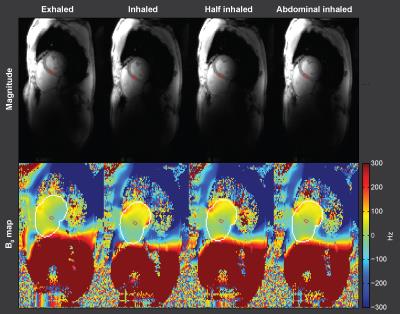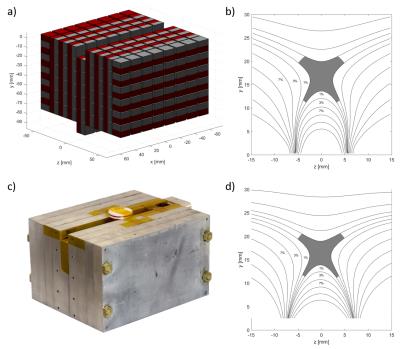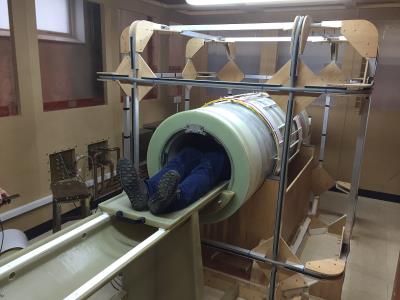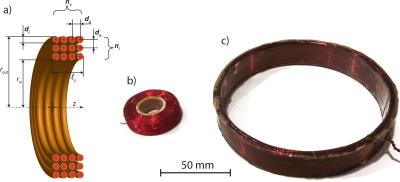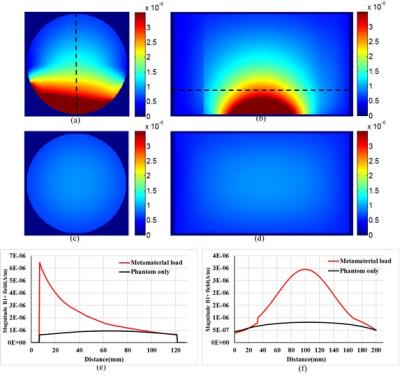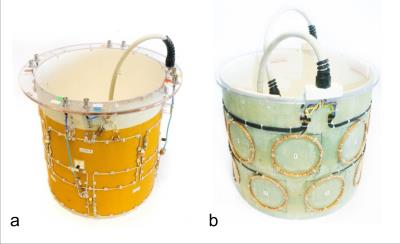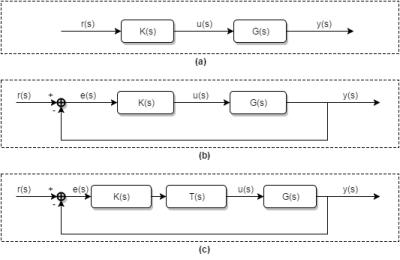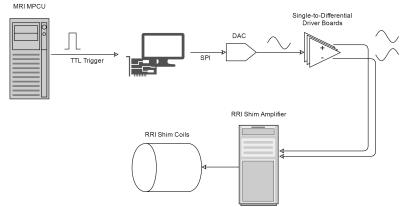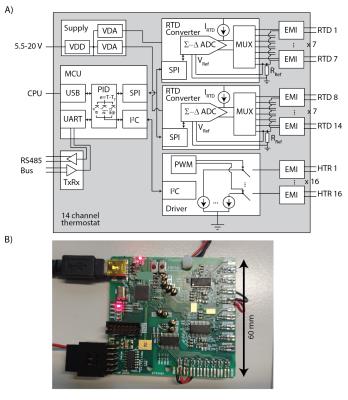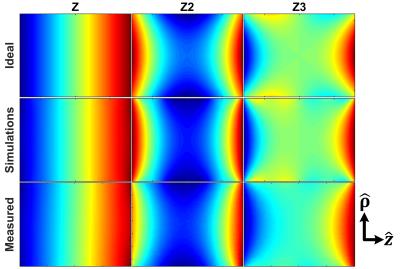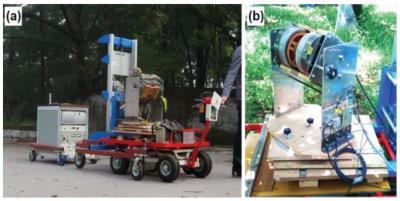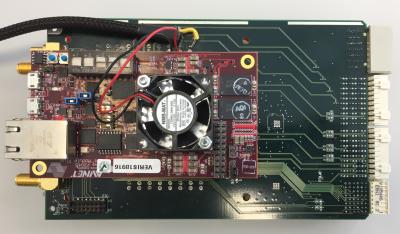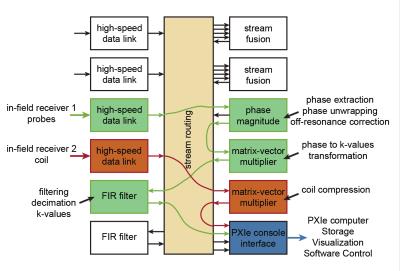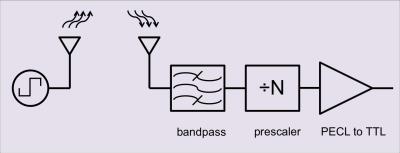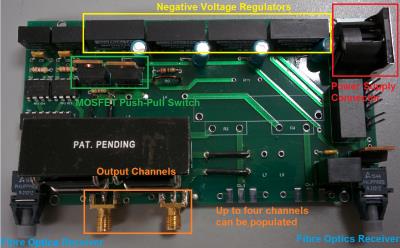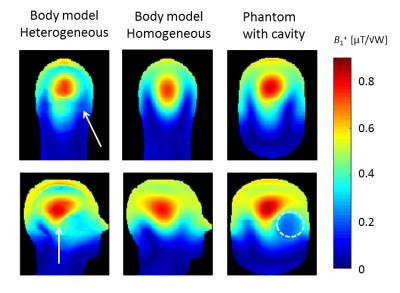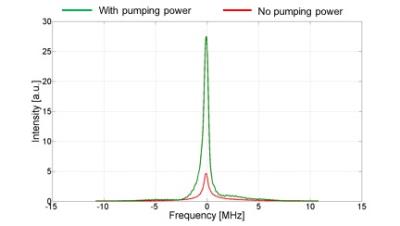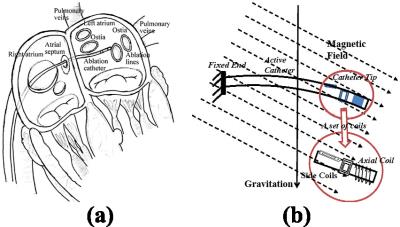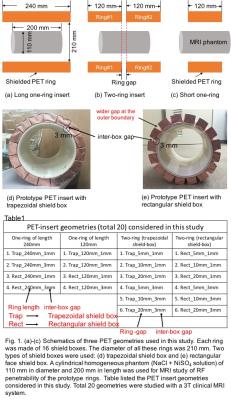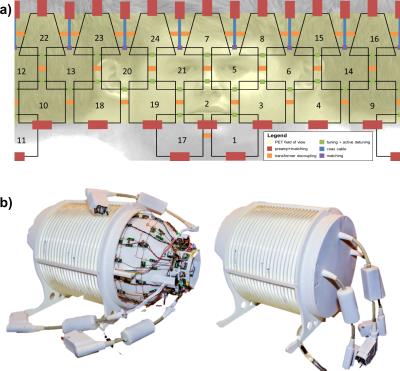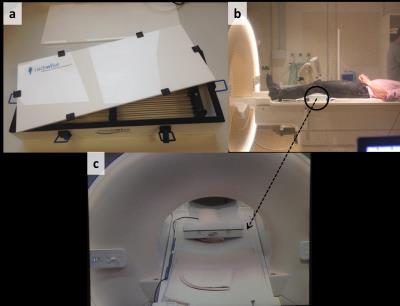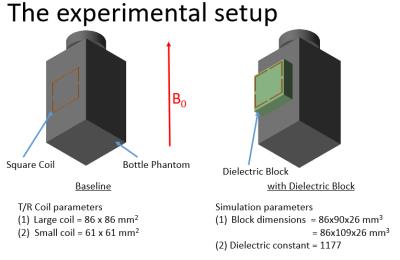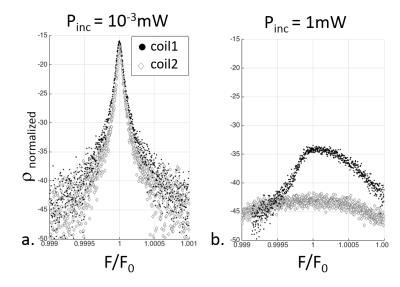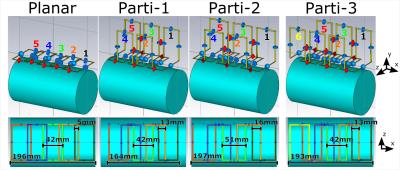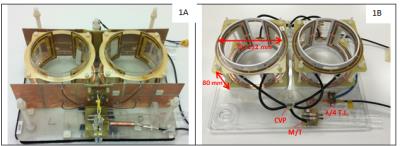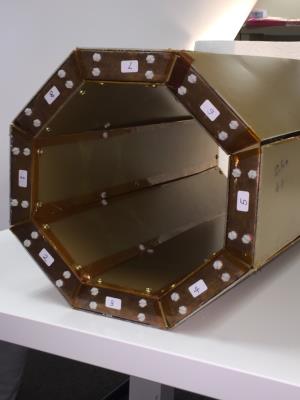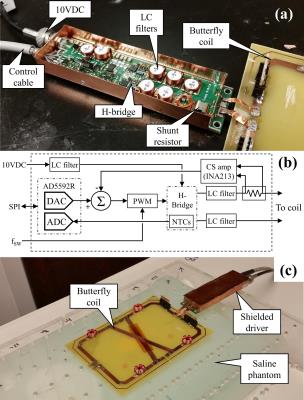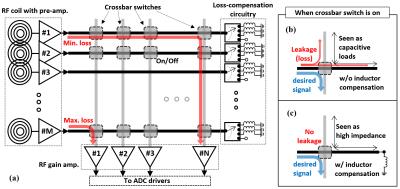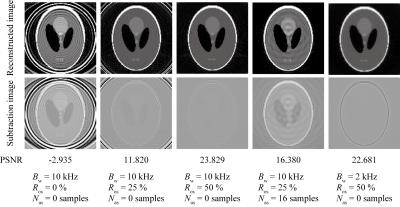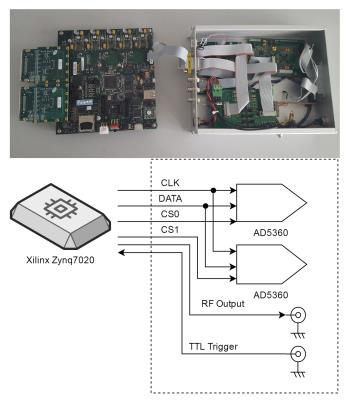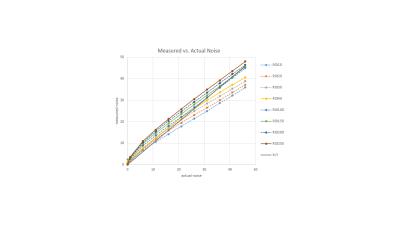RF Coils & Systems
Traditional Poster
Engineering
Wednesday, 26 April 2017
| Exhibition Hall |
16:15 - 18:15 |
|
2654.
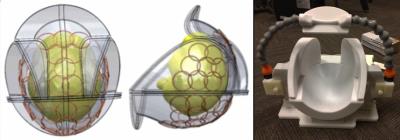 |
A high density 24 channel array coil extendable to 48 channels for human cortical MRI at 7T.
Alexander Beckett, An Vu, Scott Schillak, Lawrence Wald, David Feinberg
Coil arrays using smaller loop sizes allow increased signal close to the coil array. Such coil arrays with a large number of channels allow increased SNR across a large area of cortex, and accelerated imaging comparable to commercially available high-channel coils, with particularly good performance close to the coil array. These gains in SNR allow high-resolution (0.5mm isotropic) EPI
|
|
2655. 
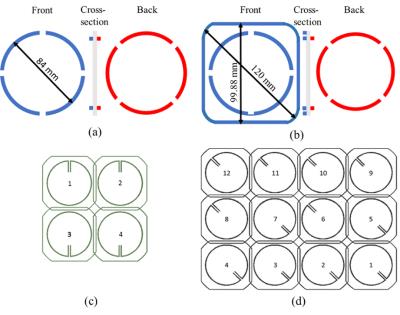 |
Towards a Flexible Transceiver Array for 7 T Cardiac MRI: Evaluation of Decoupling Ring Effects
Sajad Hosseinnezhadian, Roberta Frass-Kriegl, Sigrun Goluch, Michael Pichler, Jürgen Sieg, Marie Poirier-Quinot, Luc Darrasse, Ewald Moser, Jean-Christophe Ginefri, Elmar Laistler
In view of building a flexible 7T 2D coil array for cardiac MRI at 7 T, transmission line resonators (TLRs) with and without decoupling ring are investigated. Using 3D EM simulation and MR measurements for single elements, it could be shown that the presence of the decoupling ring does not perturb significantly the $$$B_1^+/\sqrt{P_{input}}$$$ distribution of the TLR. 3D gradient echo images for both TLRs with and without decoupling rings have been acquired. No significant degradation in the image quality due to the presence of the decoupling ring was observed.
|
|
2656.
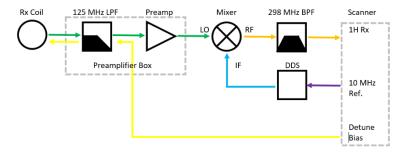 |
A Sixteen-Channel Array Coil for Carbon-13 Spectroscopy of the Breast at 7T
Matthew Wilcox, Stephen Ogier, Sergey Cheshkov, Ivan Dimitrov, Craig Malloy, Steven Wright, Mary McDougall
Biomarkers detectable by carbon-13 NMR spectroscopy have known correlations with breast cancer characterization, but in vivo 13C spectroscopy has been limited by low SNR. To counteract this, a 16-element receive coil and isolating preamplifier box was constructed for carbon-13 spectroscopy of the breast at 7 Tesla. The array was characterized on the bench and showed good results in terms of ease of tuning, low element-to-element coupling and Q values. Scanner testing using the coil was preliminary but showed successful 1H and 13C transmission and that array elements were individually able to acquire spectra.
|
|
2657. 
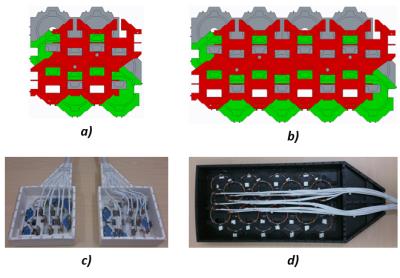 |
A Modular, Scaleable, and Customizable Phased Array Structure Suitable for Ultra-High Channel Phased Arrays
Wolfgang Loew, Christopher Ireland, Matthew Lanier, Brynne Williams, Matthew Batie, Yu Li, Randy Giaquinto, Ron Pratt, Charles Dumoulin
A novel three-layer frame was developed to enable scalable phased-array coils. The geometry of the three-layer frame allows a single 12-element tile to dock with up to four identical tiles. When adjacent tiles are docked, the overlap of coils in adjacent tiles is identical to the coil overlap within a tile. Two phased-arrays setups using 12-element tiles and integrated balun coil technology were constructed. The first contained two separate tiles and the second had two interconnected tiles. The phased-array coils were evaluated with phantom imaging experiments and with multiple in-vivo experiments.
|
|
2658.
 |
Optimal array configuration for cerebral cortex MRI at 7T: six center-fed dipoles with two loops RF coil array
Jérémie Clément, Rolf Gruetter, Özlem Ipek
Searching for optimal RF coil array for whole-brain MR applications, central-fed dipole was compared with fractionated dipole in a single and RF coil array configurations with combination of loop coils in measurements and electromagnetic field simulations in terms of B1+ transmit efficiency, field uniformity, SAR and mutual coupling in an array. High transmit field performances were shown over the cerebral cortex by using phase-only shimming with six center-fed dipoles with two loops RF coil array on experimentally measured B1+-maps and anatomical MR images.
|
|
2659. 
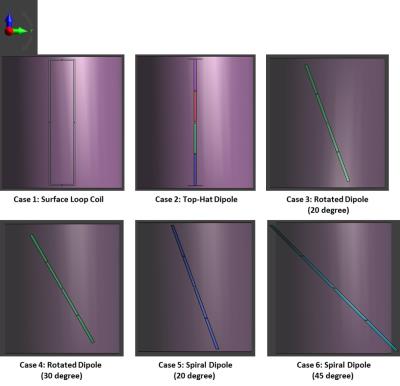 |
Structure Adjustment of Surface Dipole Antenna Elements for Body Imaging at 7 Tesla MRI
Suchit Kumar, Young-Seung Jo, Jeong-Hee Kim, Chulhyun Lee, Chang-Hyun Oh
In ultra-high-field magnetic resonance imaging (UHF-MRI), body imaging suffers from B1 inhomogeneity due to relatively short wavelength. A range of new radio frequency (RF) coil designs has been proposed to overcome this problem. As previously reported, dipole antenna had been proposed to address this B1+ inhomogeneity problem for body imaging. In this paper, structural adjustment of dipole antenna has been tried for parallel transmission to improve overall B1+ homogeneity. Surface dipole antennas with several structures are tried and compared with our top-hat dipole antenna array reported previously. Also, static RF shimming was employed to evaluate the B1 uniformity.
|
|
2660. 
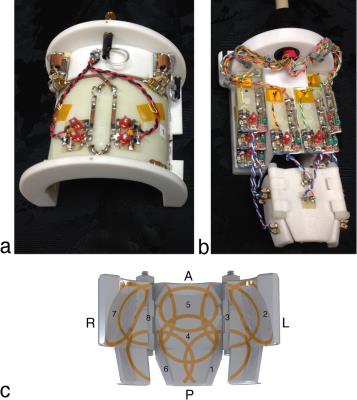 |
An adjustable 8-channel receive coil for population studies of marmosets
Kyle Gilbert, Joseph Gati, Peter Zeman, David Schaeffer, Stefan Everling, Ravi Menon
An eight-channel RF coil was developed for imaging the common marmoset at 9.4T. The coil was adjustable in width to accommodate different head sizes while maintaining high SNR, thereby facilitating the study of larger cohorts of animals. Tuning and matching of the coil did not require adjustment over the range of potential head sizes. EPI time series were acquired, showing minimal geometric distortion with a two-fold reduction factor. A two-fold reduction factor could be achieved in both the left-right and anterior-posterior directions.
|
|
2661. 
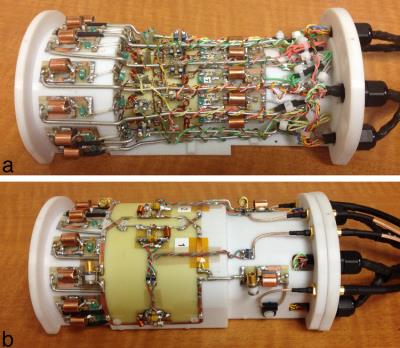 |
Fifteen-channel receive coil for high acceleration rates in UHF marmoset imaging
Kyle Gilbert, Joseph Gati, L Klassen, Stefan Everling, Ravi Menon
A 15-channel receive coil, in conjunction with a 2-channel transmit coil, was developed for imaging the common marmoset at 9.4T. The high channel count produced low geometry factors while accelerating in EPI acquisitions, thereby reducing geometric distortions with minimal impact on the SNR. This demonstrates the utility and feasibility of employing higher channel counts for functional imaging of the marmoset.
|
|
2662.
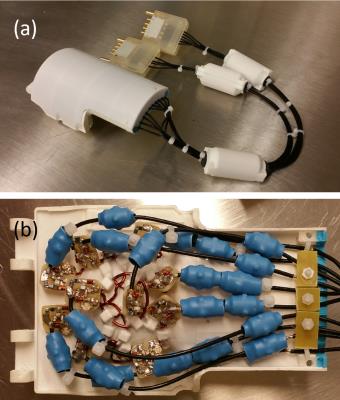 |
A 10-element receive-only RF coil array for imaging the brain of awake marmosets
Wen-Yang Chiang, Cecil Yen, Mary McDougall, Afonso Silva
A 10-element head RF coil array was developed for imaging the brain of awake marmosets. A soccer ball design was used to improve whole brain coverage and parallel imaging acceleration when compared to our previous designs. Coil clip and PLA cement were introduced to help place the small coil elements on surfaces of irregular shape and optimize geometric decoupling. The matching network provided independent adjustments of tuning, matching, active detune and preamp decoupling, greatly simplifying the construction of coil arrays in space-limited applications. Molded-in foam padding was also introduced to provide additional comfort during awake marmoset imaging.
|
|
2663.
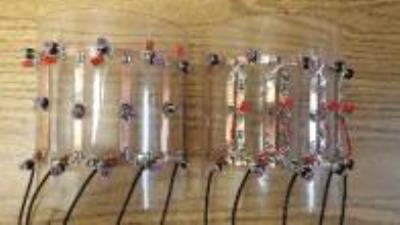 |
Ladder and Overlapped Phased Array Coil Comparison for Neck Imaging at 3 Tesla
Michael Beck, Dennis Parker, J Hadley
A ladder and overlapped phased array coils were constructed with the same number of channels and overall dimensions to see how much of a SNR performance difference there was between the two coil construction techniques. The results show that between 2 and 12 cm within a cylindrical phantom the difference between SNR was less than 3%. With negligible performance difference the ladder array can be a viable alternative to overlapped arrays if a simpler coil construction process is desired.
|
|
2664.
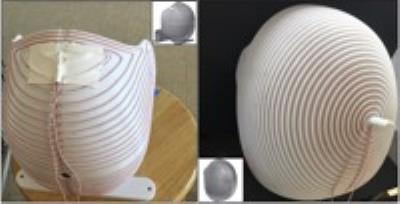 |
Quadrature Head Coil for Brain Imaging at 6.5 mT
Neha KOONJOO, Bryce Primavera, Jason Stockmann, Thomas Witzel, Lawrence Wald, Matthew Rosen
Highly-resolved proton imaging is challenging in the millitesla regime. With the aim of enhancing our previous single-channel spiral head coil for operation at 276 kHz, a quadrature head coil was designed, comprised of 2 layers (inner and outer) producing orthogonal B1 fields. Images acquired with the new quadrature coil had the same signal magnitude when compared to the single-channel coil. However, the expected √2-factor signal enhancement in combined SNR was not fully realized due to a 30% higher noise floor observed in one quadrature. Improvements in gradient amplifier filtering will significantly improve the SNR.
|
|
2665. 
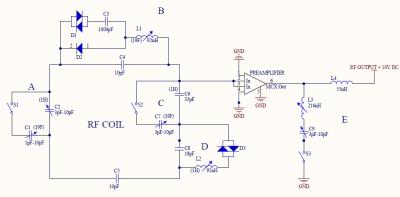 |
Dual-Tuned RF Coil system for Parallel Imaging of Human Lungs Using Perfluorinated Gases
Vishal Kampani, Randall Jones, Hal Charles, Natalie Hussey
To create a dual-tuned (1H & 19F) receive-only surface coil array for pulmonary functional imaging. This satisfies an unmet clinical need because there is currently no widely accessible 3D measure of regional lung function. As a result, the current standard of care for diagnosis and evaluation of lung disease relies nearly exclusively on global measures such as spirometry. The technical significance of this proposal is that the implementation of parallel imaging for 19F MRI would provide a means to shorten breath hold times with marginal SNR impact as well as facilitate the development of real time free breathing image acquisitions.
|
|
2666.
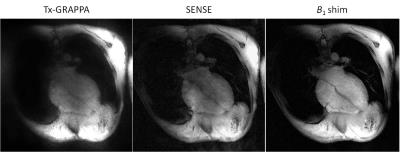 |
Ultra-high-field CAIPIRINHA modulated parallel transmit excitation for homogenous image reconstruction without RF shimming
Iulius Dragonu, Craig Buckley, Matthew Robson, Aaron Hess
Ultra-high-field (UHF) provides higher SNR than conventional, clinically available field strengths. However, UHF suffers from heterogeneous transmit B 1+ fields. At 7 T, the shortened transmit radio-frequency (RF) wavelengths have a similar value to the dimensions of the human head/thorax which may result in signal cancellation and local signal dropouts. In this paper, we propose a novel imaging scheme based on simultaneous excitation with all transmit channels. Controlled aliasing is used to encode each transmit channel independently which we term Tx-CAIPIRINHA. Tx-CAIPIRINHA has been demonstrated in-vivo. The concept uses the linear superposition of B1+ fields via the excitation flip angle which only holds true in the low flip angle regime. When normalizing to transmit efficiency, Tx-CAIPIRINHA achieved a marginally higher SNR than B1+ shimming, demonstrating the constructive combination of transmit sensitives throughout the image.
|
|
2667.
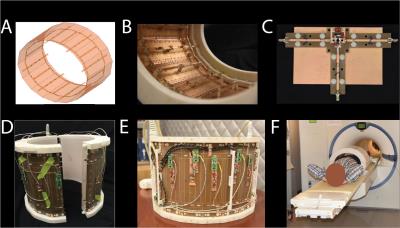 |
Towards Routine Body Imaging at 7T Using a Hybrid Dipole and Birdcage Coil Array
Jan Paska, Martijn Cloos, Graham Wiggins
Body imaging at 7T is challenging due to wavelength effects, a low sensitivity in deep tissue1, and a large variation in body sizes across the patient population. A common approach is to use close fitting coils or dipoles2,3,4, which exhibit a high transmit and receive sensitivity and are fairly load independent, but lack the easy handling necessary for routine clinical use. We aim to construct an RF coil array for general purpose body imaging for routine use that is robust, easy, and safe to handle, while retaining adequate sensitivity in the deeper regions. Given these boundary conditions, we settled on a stand-off design5 with an RF shield. Thus, consciously sacrificing some sensitivity to improve handling and safety. After extensive optimization we converged to an optimal coil array consisting of a transceive dipole array complemented with a birdcage array for reception only. The array was completed and a sensitivity analysis with respect to body sizes was performed.
|
|
2668. 
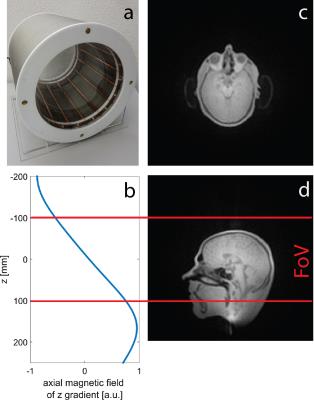 |
An RF birdcage coil designed for an insert gradient coil dedicated to short-T2 MRI
Manuela Rösler, Markus Weiger, David Brunner, Thomas Schmid, Romain Froidevaux, Klaas Pruessmann
Two major challenges for MRI of short-T2 tissues are creating large gradient strengths and avoiding signal contamination from hardware parts, in particular the RF coils. In this work, to enable short-T2 MRI with a dedicated insert gradient coil, an RF birdcage coil was designed with a) minimized background signal and b) optimized B1 field to prevent aliasing associated with the limited monotonic range of the gradient.
|
|
2669.
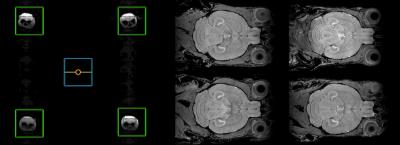 |
Multiple-Mouse Magnetic Resonance Imaging with CryoProbes
Aidin Arbabi, Dulcie Vousden, Leigh Spencer Noakes, Jun Dazai, Shoshana Spring, John Sled, Jason Lerch, Mark Henkelman, Brian Nieman
Multiple-mouse MRI was implemented on a 7-Tesla magnet with four Cryogen (liquid helium)-cooled radio frequency probes. The high signal-to-noise ratio offered by the probes enabled spatial resolutions of 60 μm isotropic in <2 hours, a significant improvement for in vivo anatomical imaging of the mouse brain. Several 3D pulse sequences including FLASH/MP2RAGE/RARE were implemented for multiple-mouse acquisition. Manganese-enhanced T1-weighted images were obtained at two different resolutions of 60 μm and 75 μm. Results demonstrate the combined benefits of cryogen-cooled coils and multiple-mouse MRI.
|
|
2670.
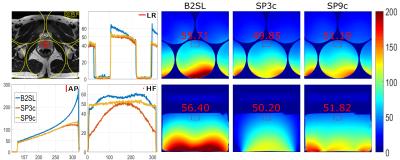 |
An SNR Optimized Quadrature Reception Posterior Array for Prostate Imaging at 3 Tesla
Jorge Chacon-Caldera, Alexander Fischer, Matthias Malzacher, Lothar Schad
Increasing signal-to-noise-ratio (SNR) in prostate MRI could facilitate the diagnosis and characterization of prostate cancers. In this work, we built a quadrature posterior surface array that aims to increase local SNR at the prostate. The coil was compared to 3 and 9 channels of the standard spine array using phantom measurements. Respectively, SNR gains of 12 and 9% were obtained using a realistic region-of-interest (ROI). Further work will be undertaken to translate the SNR gains to in-vivo prostate imaging at 3T.
|
|
2671. 
 |
New design of flexible surface coil with variodes and remote detuning
Wenming Li, Shu Du, Jianmin Wang
New design of flexible surface coil was presented. Voltage-controlled variodes instead of trimmers are used for remote coil frequency adjustment; λ/4 impedance transforming circuit are used to enable remote detune, thus detune circuits with big rigid components are moved out from the antenna part. By doing this, the antenna is covered by soft foam seamlessly which improved the flexibility significantly. Design was tested on four-element arrays. Experiments on both phantom and invivo testing show good results with this design.
|
|
2672.
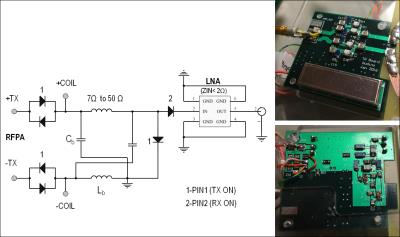 |
Human Brain Imaging at 7T With On-coil Transceivers
Natalia Gudino, Qi Duan, Jacco de Zwart, Stephen Dodd, Joe Murphy-Boesch, Peter van Gelderen, Jeff Duyn
On-coil current-source switch-mode amplification presents high power efficiency, allows direct control of the transmit field (B1), and decoupling of elements through the amplifier output impedance. These are important advantages over conventional remote voltage-mode quasilinear amplification that should allow more efficient and safer implementation of a multi-channel transmit system. Following this approach, we present an optically controlled transceiver design that was used for initial safety assessment of the technology toward the implementation of a high channel-count pTx array for brain imaging at high-field. We acquired human brain images with this technology at 7T
|
|
2673.
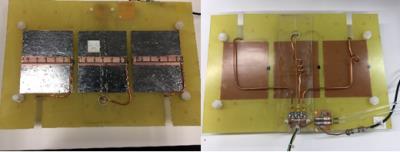 |
An adjustable field-of-view rung element for 7T transmit array coils using forced current excitation
Jiaming Cui, Chenhao Sun, Dheyaa Alkandari, Steven Wright
This abstract reports a switchable coil element which uses “forced current excitation”. The coil consists of three aligned rungs, with a total length of 37 cm. Any one or more of three rungs can be easily selected to provide a variable length or position field-of-view. The forced current approach ensures equal current on the selected rungs to give a uniform field distribution along the length of the field-of-view. Bench measurements demonstrate the expected efficiency improvement when only a single rung is selected and the uniform field pattern.
|
|
2674. 
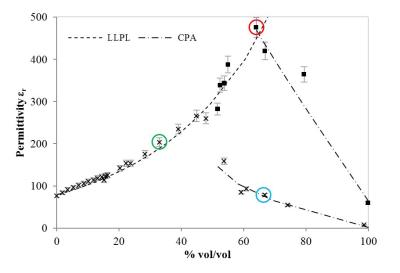 |
Optimization via Ultra-high Permittivity Materials of Pad Effects in Dielectric Shimming at 7 Tesla MRI
Ana Luisa Neves, Redha Abdeddaim, Stefan Enoch, Jerome Wenger, Johann Berthelot, Anne-Lise Adenot-Engelvin, Nicolas Mallejac, Franck Mauconduit, Lisa Leroi, Alexandre Vignaud, Pierre Sabouroux
The influence of air fraction on the permittivity of BaTiO3 aqueous mixtures was assessed, with the aim of obtaining high permittivity mixtures. For extremely saturated mixtures (>50%v/v), the air fraction of the mixture plays a great role in determining εr, and by applying high pressure it is possible to go beyond the maximal value described in dielectric shimming literature. A BaTiO3 1cm-thick pad was manufactured (εr =470) and tested in a 7T MRI, as well as a conventional saturated pad (≈40%v/v, εr=200). Results show an overall signal improvement when using higher permittivity pads and the possibility to reduce pad-thickness.
|
|























